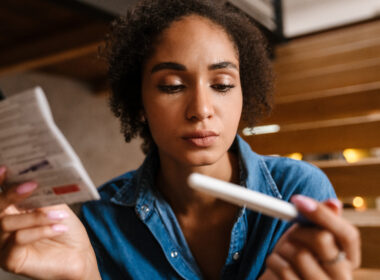Five years ago, few people had heard of cycle syncing, but it has surged in popularity thanks to viral videos on TikTok and other social media sites. For young women who came of age in the 2000s or early 2010s, the idea that wellness and nutrition can work with your menstrual cycle rather than against it is revolutionary and exciting. Videos of influencers doing high-intensity interval training (HIIT) during ovulation then taking a step back during their luteal phase are a welcome change from the conventional health wisdom of twenty years ago, which focused mainly on weight-loss and encouraged unhealthy dieting practices.
A new app called 28, founded in 2022 by Evie Magazine Editor-in-Chief Brittany Hugoboom, leans into this trend by bringing an algorithm to women to help them organize their life around their cycle. Even though I already use the Sympto-Thermal Method of fertility awareness for cycle charting and family planning, I decided to use 28 for a few cycles to see if this cycle syncing app could help me not only better understand my cycle, but also reach fitness and lifestyle goals with greater ease. Here’s my review of the 28 app as someone with training in an official fertility awareness method (FAM).
What is the purpose of the 28 app?
Hugoboom founded 28 to fill a need in the women’s wellness and fitness space: personalization of health strategies based on each woman’s menstrual cycle. She wanted to create “an all-in-one solution that allowed women to take control of their bodies in a natural, healthy way… that celebrates the feminine, and a mindset that emphasizes balance over extremes,” according to her interview with Grazia Magazine.
Features in the free version vs. the paid version
28’s features include tailored exercise and nutrition recommendations, insight on how your mind or body might be feeling at each point in your cycle, and tidbits on your romantic or social life. In the free version of the app, users are offered a handful of workout videos for each cycle phase that vary in intensity (and are labeled as such), as well as nutrition tips and a few recipes which emphasize various foods during each phase. There is also a premium option for 28, which unlocks even more workouts and a large number of additional recipes, plus detailed grocery lists. Generally, you can get the idea of what 28 offers with just the free version, but if you need more help in planning meals and want more varied workouts, the premium version might be worth a shot.
28 provides a cycle syncing roadmap for all four cycle phases
28 gives specific guidance for each part of the cycle, dividing it into the menstrual, follicular, ovulatory, and luteal phases. Here’s a taste of the app’s advice for each phase, as well as how I personally took this advice and integrated it into my own life:
Menstrual phase
In the beginning of the menstrual phase, 28 advises spending more time doing self-care, as hormone levels are at their lowest. Your emotions might be sensitive or moody, and you should respect your body’s need for rest during this time. This is the ‘winter’ of your cycle, meaning that it’s normal to feel sluggish and desire more relaxation and nourishment, both physically and emotionally. The workouts during menstruation are light and focus mainly on stretching and slow yoga. As for nutrition, 28 says to prioritize iron-rich foods, cruciferous veggies, complex carbs, and plenty of water.
This was the phase that I focused on following the app’s recommendations the most, as I experience pretty strong symptoms during this time that I hoped to alleviate. I took the first two days of my cycle to only rest, then slowly added back in outdoor walks and the stretching workouts on the app. I found the workouts to be a good intensity level and they did help alleviate some back pain that I was experiencing.
The main tip that I loved during this time was the nutrition guidance. I, like many others, often crave sweets and carbs before and during my period, but I tried to instead focus on iron and nutrient-rich foods like red meat and beef liver (I like to hide liver in beef recipes using this method). I found this helped my energy levels, and by day three of my period I was already feeling mostly back to normal. From what I can tell, the combination of rest on the first two days plus gentle movement and high-iron foods was what helped decrease some of my period symptoms.
Follicular phase
The nickname 28 gives for the follicular phase is “Awaken,” and it’s described as the time when your body is “replenishing” itself, with both estrogen and testosterone levels rising. This phase is an optimal time to build muscle, so many of the workouts are focused on this goal. 28 encourages pushing yourself towards your goals, spending more time on creative pursuits as your energy increases.
Nutrition advice during this phase varies. The beginning of “Awaken” includes a recommendation to increase complex carbs in order to stabilize your mood and blood sugar with rising hormone levels. Nearing ovulation, 28 recommends focusing on increasing your vitamin C intake, which has been shown to promote progesterone, a key hormone post-ovulation [1].
During my follicular phase, I chose to increase my workouts and try some of the more difficult routines on 28. I really enjoyed these strength-focused workouts, and combining them with a daily brisk walk felt great with my increased energy. As for lifestyle shifts, I even tried to batch more of my tasks around this time (plus during ovulation) in order to take advantage of my expanded capacity for work and creativity. I was happy to notice that I saw a marked increase in productivity (compared to the week prior) when I purposefully added more to do’s on my plate at this time.
Ovulation phase
Ovulation is the shortest phase on 28 and the app explains that this should be the peak of your cycle both physically and mentally. Your mood will most likely be positive, and you’ll be experiencing a high sex drive and desire for romance. 28 chooses a bright yellow color to represent this phase, which matches the upbeat workouts and flavorful recipe options users are presented with during these days.
Workouts during ovulation become even higher intensity, with aerobic cardio and HIIT being two of the top listed options. Nutrition tips center on eating more essential fatty acids to help support the release of a healthy egg and maintain hormonal balance with increased saturated fats. This was the phase when I most appreciated the nutrition tips, as I had never considered the importance of increased fats during ovulation. I chose to incorporate more avocado, high-quality cheeses, and grass-fed butter into my diet at this time. These were a great accompaniment to the more difficult workouts.
Luteal phase
Everything suddenly shifts once you’re in the luteal phase, which 28 calls “Balance.” The app advises that your energy might shift inward at this time, making the luteal phase a great time for personal reflection. Since hormone levels are steadily dropping throughout the luteal phase, you may want to socially withdraw and focus more on getting quality sleep (which can naturally be more difficult during this phase).
Luteal phase workouts have titles like “PMS Pilates” and begin to gradually decrease the intensity levels. This phase also included my favorite workout routine of the app, “Radiant Core,” a 10 minute ab workout that is just difficult enough to sweat but easy to fit into a busy day. As for nutrition, 28 advises increasing the amount of fiber in your diet, including eating more fruit to help curb the sugar cravings which can become common as you get closer to your period. 28 also gives the tip to consume anti-inflammatory agents like ginger in the days leading up to your period, as they are proven to help alleviate PMS and period symptoms.
I’ve written about period pain in the past and the role that ginger can play in helping decrease symptoms like cramps, so I appreciated seeing this bit of wisdom in 28’s algorithm [2]. I chose to make drinking ginger tea during the end of my luteal phase (plus the first few days of my period) a priority, and I did notice a small reduction in my period pain when I was consistent about it.
What 28 does really well
There were many aspects of 28 that I loved, especially the high-quality workout routines. As a full-time mom to a toddler, it can be difficult to go to the gym regularly, so I appreciated having tailored workouts that were short and easy to do at home. What I enjoyed most about 28 was how it gave me a mindframe for viewing my cycle that normalized the ups and downs I often experience. It gave me an explanation for why I just wanted to stay home and relax with my loved ones on certain days, while on others I itched to be social and have more physical movement. I grew in awareness of my innate emotional and physical feelings throughout the month, and in turn felt more aware of how best to structure my life during the different phases.
The drawbacks of the app and what it’s missing
There is one glaring problem with 28 that I would be remiss not to mention: it is not a Fertility Awareness Method, nor is it a way to actually track your cycle and fertility. Although there is a tab to record symptoms and cycle biomarkers like cervical mucus, your recorded observations do not change your phase in the app. So, in a nutshell, 28 determines what phase you’re in by using the rhythm method. This method operates purely on your average number of period days and cycle days, then gives you a set number of days per phase.
For these reasons, 28 is not a reliable family planning method (even if the days will match up with many women’s regular cycles). That’s probably why 28 does not advertise itself as a method of FAM or NFP! However, I think using it in combination with a FAM method of charting could be helpful to gain a fuller picture of how your body is cycling. The app was more or less accurate for my cycle, but I only knew this because I chart using the Sympto-thermal method of FAM, which gives me more precise data on my fertility.
Cycle syncing with 28: worth it?
Generally, using 28 was a worthwhile experience that gave me many things to consider when it comes to alleviating period symptoms, incorporating optimal nutrition and fitness for cycle phases, and how to best organize my life at various times of the month. I would love if the app could more accurately move you to a new phase depending on the fertile symptoms you record (especially if it added options like basal body temperature (BBT) and luteinizing hormone (LH) testing), but it’s possible to get a similar effect by combining 28 with another charting application. I would also love to see citations of sources for the research used in the app.
If you’re someone who has very little knowledge of cycle syncing and you’re interested in improving your health, 28 could be a great place to start. It might just be the perfect introduction to understanding your body on a deeper level. Cycle syncing is a fairly new and innovative way of looking at feminine health, and it’s exciting to see more options for women who are interested in reaching health and fitness goals without disregarding the natural rhythms of their bodies.
References:
[1] Coker SJ, Dyson RM, Smith-Díaz CC, Vissers MCM, Berry MJ. Effects of Low Vitamin C Intake on Fertility Parameters and Pregnancy Outcomes in Guinea Pigs. Nutrients. 2023 Sep 22;15(19):4107. doi: 10.3390/nu15194107. PMID: 37836389; PMCID: PMC10574174. [2] Daily, James W et al. “Efficacy of Ginger for Alleviating the Symptoms of Primary Dysmenorrhea: A Systematic Review and Meta-analysis of Randomized Clinical Trials.” Pain medicine (Malden, Mass.) vol. 16,12 (2015): 2243-55. doi:10.1111/pme.12853






